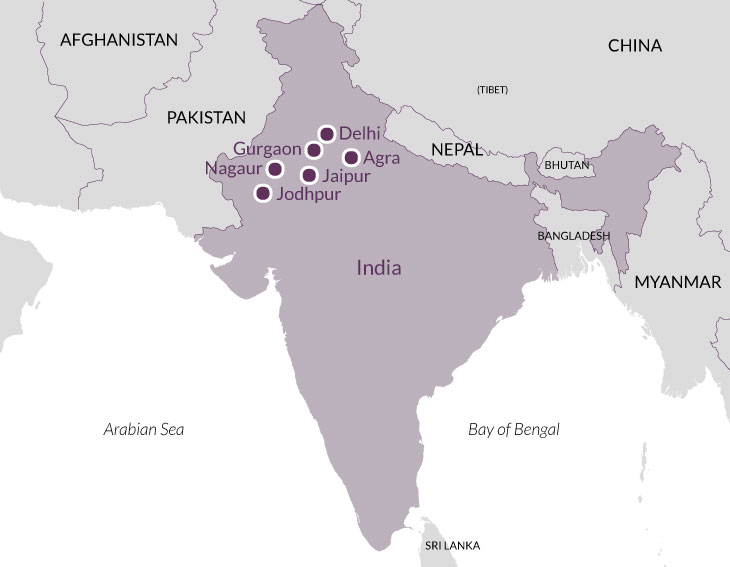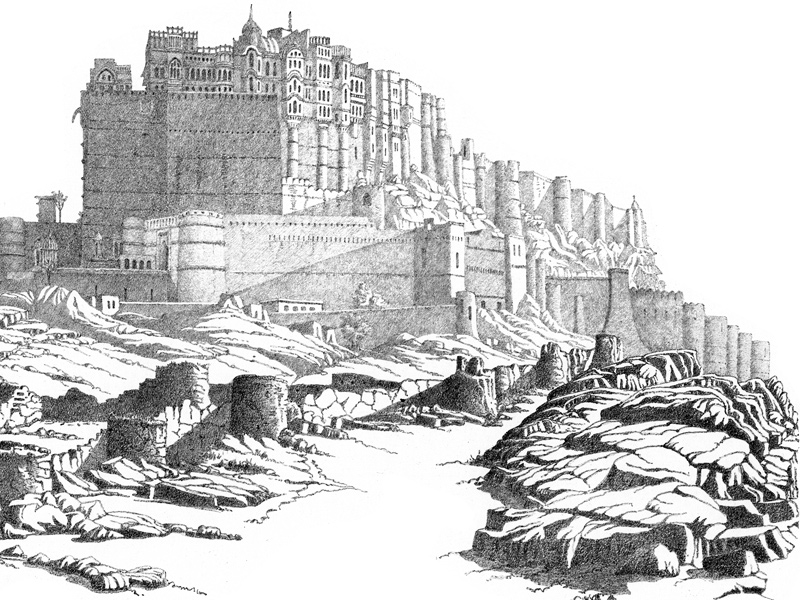Overview
The Mughals, the last and most refined of India’s Muslim dynasties, originated in Central Asia and Afghanistan, being descendants of both Timur (Tamerlaine) and Genghis Khan. Babur conquered the Kingdom of Delhi in 1527, and his successors extended the empire to include at its peak all the Subcontinent except for its southernmost tip. They remained rulers until 1857, though after the death of the emperor Aurangzeb in 1707 their power and territories withered rapidly. During their period of glory, the dynasty ruled one of the great empires in history and the body of architecture bequeathed by emperors and empresses, warlords and administrators, nobles and governors, ranks among the world’s finest.
The Rajputs, rulers of large tracts of northern India, trace their origins to the sixth century ad or earlier. They built some of India’s greatest temples, established a sophisticated court culture and, all too ready to put into practice a chivalric and militaristic ethos, became the main bulwark of resistance to Islamic invasion.
It is ironic therefore that Rajputs and Mughals came to an accommodation. Rajput maharajas served as imperial commanders and as regional governors, while at home, in the fortified cities of Rajasthan, they developed a courtly culture in tandem with that of their imperial overlords but drawing too on older traditions.
This composite courtly culture is among India’s best known and most admired phenomena, permeating a range of arts from painting and textiles to jewellery and precious artefacts. The proper setting for all these arts were the courtyards and pavilions of their palaces, which rank among the world’s most striking and beautiful works of secular architecture. Their appearance is further enhanced by their setting in the dramatic landscape of Rajasthan, which encompasses both desert plains (in the north-west), and rugged hills and ravines (in the south-east).
This tour covers many of the finest forts, palaces, gardens and cities built by the Mughals in Delhi and Agra and the Rajputs in Rajasthan. Agra is of course much visited, but the tour allows time to explore the city’s other great monuments that place the Taj Mahal in context. Jaipur, the celebrated capital of Rajasthan, was built according to the Vastu Shastra, the architectural treatise from the Vedic age which enjoyed a revival under the Hindu rulers of Rajputana in the eighteenth century. Including the most famous sites and some less known ones, the tour also visits the best museums, public and private. A distinguishing feature is that longer is spent at the sites than is the norm for tours to Agra and Rajasthan, resulting in a much deeper understanding and appreciation of this extraordinarily rich episode of artistic and architectural creation.
Day 1
Delhi. The tour begins in Delhi with a pre-lunch talk in the hotel (flights from London are not included – see Practicalities). Rooms are available at the hotel from 2.00pm on the 15th November, allowing for an early check-in. The first Islamic city of Delhi was established in 1193 by the conquering ruler Muhammed of Ghur; the afternoon outing is to the earliest Islamic buildings in India, the towering 12th-century minaret of Qutb Minar and its mosque, built using masonry from plundered Hindu temples. A stroll in the serene Lodi Gardens takes in the 15th-century tombs of the Sayyid and Lodi dynasties, relatively simple but beguiling in design. Overnight Delhi.
Day 2
Delhi. The Red Fort and the Friday Mosque, major monuments of Mughal rule, dominate Old Delhi. As we shall so often see, the formidable bulk of the fortress shelters exquisite delicacy (pietra dura work of Shah Jahan’s 1640 throne pavilion). The Jami Masjid is India’s largest mosque. Then by auto-rickshaw through the labyrinthine streets near Chandni Chowk. The Purana Qila, the Old Fort, marks the site of Emperor Humayun’s 16th-century capital. His tomb is a pioneering example of Mughal architecture and garden design. Overnight Delhi.
Day 3
Delhi, Sikandra, Agra. In the morning, drive to Agra. Akbar’s mausoleum (1613) at Sikandra on the outskirts of the town, far surpasses that of his father, Humayun, in size and elaboration, being set in a traditional char-bagh nearly 1 km2 and encrusted with domed marble kiosks. It has no central dome unlike other Mughal mausolea. Set in a pleasure garden on the banks of the River Yamuna in Agra, the exquisite tomb of Itimad ud Daula (1628) is a pioneer of intricate marble inlay work. First of two nights in Agra.
Day 4
Agra. The Taj Mahal (1631–47) was famously built by Shah Jahan as the tomb of his favourite wife. Rise early to see it in the first light of day; despite inevitable scepticism, it is likely that you will indeed conclude that this is the most beautiful building in the world. Return to the hotel for breakfast before visiting Agra Fort, first constructed by Akbar (1565–73) and added to by Shah Jahan and Aurangzeb. Among the highlights are Akbar’s Jehangiri Mahal, with high-quality sandstone carvings of Hindu influence; the Sheesh Mahal, with its mirror-mosaic interiors; and the elaborately decorated Musamman Burj pavilion. The rest of the day is free. Overnight Agra.
Day 5
Fatehpur Sikri, Jaipur. Fourteen years after its inception in 1571 Akbar abandoned his new capital at Fatehpur Sikri, but the most important elements of the city had been constructed. The palace complex consists of beautifully carved red sandstone pavilions amid a series of courtyards. In the Diwan-i-Khas (private assembly hall) the central pillar fuses a spectrum of architectural styles and religious symbols. Continue to Jaipur for the first of three nights.
Day 6
Jaipur. Athwart a natural ridge below, the magnificent yellow walls of the 17th-century Amber Palace conceal fine craftsmanship – mirrored chambers, latticed windows, carved alabaster. The Nahargarh (Tiger) Fort houses the lavish 19th-century Madhavendra palace built for the Maharaja’s nine wives. Overnight Jaipur.
Day 7
Jaipur. Founded in the 18th century by the prominent Rajput ruler Sawai Jai Singh, the grid design of Jaipur demonstrates its creator’s obsession with mathematics and science. The City Palace contains an unsurpassed collection of textiles and arms. The Jantar Mantar, the 1730s observatory, is equipped with massive astronomical instruments that are astonishingly accurate. A walk takes in the many-windowed façade of the pink sandstone Hawa Mahal (Palace of Winds) and attractive havelis. Overnight Jaipur.
Day 8
Jaipur, Nagaur. In the morning, drive through the desert to Nagaur, one of the earliest Rajput settlements and an important Sufi centre (4 hours). The vast Ahichhatragarh Fort was founded in the 4th century, built in the 11th and developed and embellished in the 18th. From its ramparts, the tapering minarets of the Akbari Mosque are visible in the distance. First of two nights in Nagaur.
Day 9
Nagaur. Pre-Mughal and Mughal architecture is well preserved in the palace chambers (linked to the hotel by a corridor); the Akbari Mahal, built to commemorate the visit of the Emperor Akbar in 1570, has some original floral murals, while the Hadi Rani Mahal houses some 16th-century murals in shades of green depicting daily and courtly scenes. The rest of the day is at leisure. Overnight Nagaur.
Day 10
Nagaur, Jodhpur. Drive through the desert to Jodhpur. The capital of one the largest Rajput states in western Rajasthan is presided over by the magnificent Mehrangarh Fort. Described by Kipling as the ‘work of angels, fairies and giants’, it was built in 1459 and has some of the most imposing fortifications in the world. The afternoon visit is followed by a private dinner in the fort’s garden. First of two nights in Jodhpur.
Day 11
Jodhpur. The visit to Mehrangarh Fort examines the painting tradition of the Marwari Rajputs, with special admission to the gallery led by the curator. The buildings of the lively Old City are painted in a variety of blues, originally the colour denoting the homes of Brahmins and a convenient insect repellent. Overnight Jodhpur.
Day 12
Jodhpur, Delhi. Fly to Delhi (Jet Airways). Overnight Delhi (Gurgaon). Day 13: Delhi. Car transfers to Delhi airport can be arranged for your onward journey.
Price, per person
Two sharing: £5,920. Single occupancy: £7,240
Included
Arrival and departure airport transfers; flights with Jet Airways: Jodhpur to Delhi; travel by private air-conditioned coach and people carriers; accommodation as described below breakfasts, 8 lunches and 11 dinners with wine or beer, water and coffee; all admissions; all tips; the services of the lecturer, tour manager and local guides.
Flights
Flights from London to Delhi are not included in the price of the tour. We will send the recommended flight options when they come into range (December 2018) and ask that you make your own flight reservation. Please ensure you have travel insurance that protects you in the unlikely event that the tour is cancelled.
Visas
Required for most British nationals, and not included in the tour price. We will advise all participants of the process.
Accommodation
The Taj Mahal Hotel, New Delhi: a modern and comfortable hotel with an attractive garden and swimming pool. The hotel is well-situated in the heart of Lutyen’s Delhi and caters for both the business and leisure traveller. Trident Hotel, Agra: comfortable, well-run, modern 4-star close to the main sites with a spacious garden. Trident Hotel, Jaipur: a modern 4-star hotel on the outskirts of the city. Ranvas, Nagaur: a 17th-century palace converted into a luxury hotel. There are no twin-bedded rooms. Raas, Jodhpur: a boutique hotel combining modern and traditional design. The Leela, Gurgaon: a 5-star hotel conveniently close to the airport.
How strenuous?
A good level of fitness is essential. Unless you enjoy entirely unimpaired mobility, cope with everyday walking and stair-climbing without difficulty and are reliably sure-footed, this tour is not for you. A rough indication of the minimum level of fitness required is that you ought to be able to walk briskly at about three miles per hour for at least half an hour, and undertake a walk at a more leisurely pace for an hour or two unaided. You may be on your feet for lengthy stretches of time. Uneven ground and irregular paving are standard. There are some fairly steep ascents to forts and palaces. Unruly traffic and the busy streets of Delhi, Jaipur and Jodhpur also require vigilance. There are four 4-hour long coach journeys where facilities may be limited. Average distance by coach per day: 44 miles.
Are you fit enough to join the tour?
Group size
Between 10 and 22 participants.
Travel advice
Before booking, please refer to the FCDO website to ensure you are happy with the travel advice for the destination(s) you are visiting.

